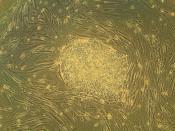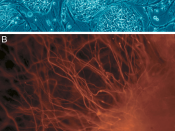Imagine this scenario: Hannah Lee Gavin attends George Mason University, takes a couple night classes and must walk a ways, on the dark, often desolate, path that leads from her car to class. One daunting evening she is abducted, raped, and to her distress impregnated. On the other side of the diminutive town Michael Jefferies is debilitated from Parkinson's disease. Now word of Michael's condition reaches Hannah and she decides to sacrifice her embryo and transplant the dopamine neurons from human stem cells to prolong Michael's life ("Stem Cell Basics" 2). As an eighteen-year-old college freshman Hannah is in no way capable of raising a child; she is capable, however, of saving a life. Stem cell research comprises a myriad of possibilities in disease treatments, is religiously accepted, and not as heinous of an act as most ethicists think. The research of stem cells, in order to save lives, is an ethical field of science.
In only a few years from now, when a doctor diagnoses a patient with a life threatening disease or injury, that patient may hear the words "stem cells" come out of the doctor's mouth. What does this mean for the patient? It means an alternative to living a better and longer life. This very issue raises some moral questions to be answered. When a patient hears the phrase "stem cells," they usually think of an embryo. In the early stages the embryo is made up of about 150 stem cells. When the embryo is needed, the stem cells are only taken from them when they are a few days old. These stem cells are nature's bank slates, capable of developing into any one of the more than 200 cell types found in the human body ("Stem Cell Basics" 7). Once planted into the body,


